Commercial Aircraft Values: CAPA's partner Oriel looks at the prospects for 2015
January, as befitting the two headed Roman God who gives his name to the month, is a time for reflection and expectation.
So Oriel, CAPA's partner in leading fleet data, has put commercial aircraft values under the spotlight. With the usual turbulence in the industry compounded by the multiple flow on effects of the oil price slump, 2015 looks likely to be another year where staying agile - and knowledgeable - will be essential.
This report covers the outlook for each of the main categories of aircraft: in-production narrowbodies; out-of-production narrowbodies; in-production widebodies; out-of-production widebodies; widebody freighters; regional jets; and turboprops - along with a global overview.
A B+ for 2014; could have been better if the first half flowed through to 2H
At the beginning of 2014 there was undeniably a feel good factor for most sectors within commercial aviation and this optimism, if we exclude widebody cargo aircraft, was not misplaced. Indeed the improvement in values has probably been better than many hoped. Aircastle noted in its filings the exceptionally strong market, which enabled the lessor to dispose of several mid-life assets at favourable pricing.
At the ISTAT European conference, three of the lessor panellists talked to the top of the market.
If we had to put a mark on the end of year Report Card a B+ would probably be fair. However we would contend that if the card had been scored at the end of summer/early autumn the mark may have been better?
The Avolon IPO and the flurry of well-received securitisations from Apollo, Jetscape and Aldus are evidence of the regard with which commercial aircraft are held in the US capital markets, which bodes well for 2015. The collapse in the oil price has been warmly received by airlines (maybe not by those with unfavourable hedges), and arguably will give a boost to consumer spending which is an important component in the demand for air travel.
US Gulf Coast Jet Fuel (USD per barrel): Jan-2014 to Jan-2015
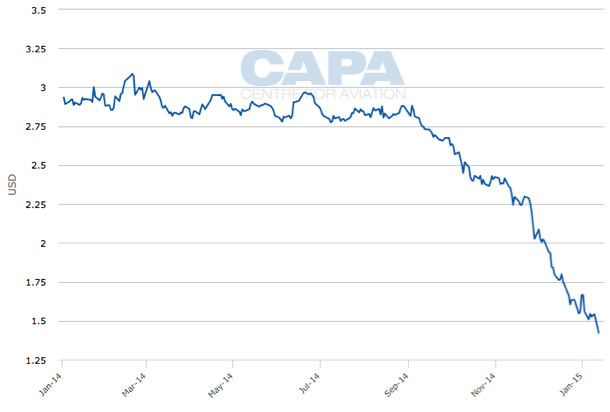
However it should be remembered that for airlines whose currencies are weak against the dollar, the full impact of those declines will not materialise. There is also an argument that the weaker oil price is symptomatic of diminished demand, as many leading economies continue to suffer sub-standard levels of growth. The one positive from this is the likelihood that interest rates are unlikely to rise dramatically in 2015.
There have been suggestions that the corollary of the lower oil price is a pickup in the fortunes of the older generation of aircraft and reconsideration of some orders. If either is true, in our opinion, it will be at the margins. Lower fuel burn, while important is only one criterion, maintenance costs and improved reliability are also strong reasons to buy new.
As at 15-Jan-2015, the median retirement age of commercial aircraft was 33.5 years, which could be reduced significantly as newer and more efficient aircraft are introduced.
Commercial aircraft retirement ages
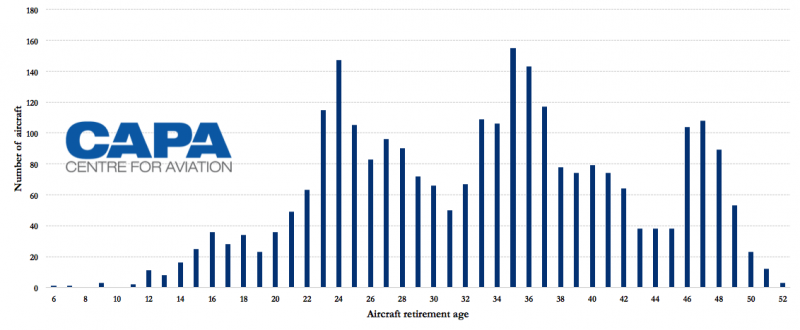
The problems in Russia have the potential if not to undermine the market, certainly to become a dampener. The collapsed rouble and measures taken to support it have hurt the airlines and a number have or will be taking drastic action to return or dispose of aircraft.
2015 a year of mixed signals, making projections difficult
Against this backdrop of mixed signals, anticipating value movements in 2015 is more problematic than was the case in 2014.
The headline comment is that we at Oriel estimate that 2015 will be the peak of the value cycle, values tend to be a lagging characteristic. However of more interest is the behaviour within each broad aircraft sector and how long the peak will be maintained: will it be Eiger or Table Mountain shaped?
Market values compared to base values, change from 2014 to 2015
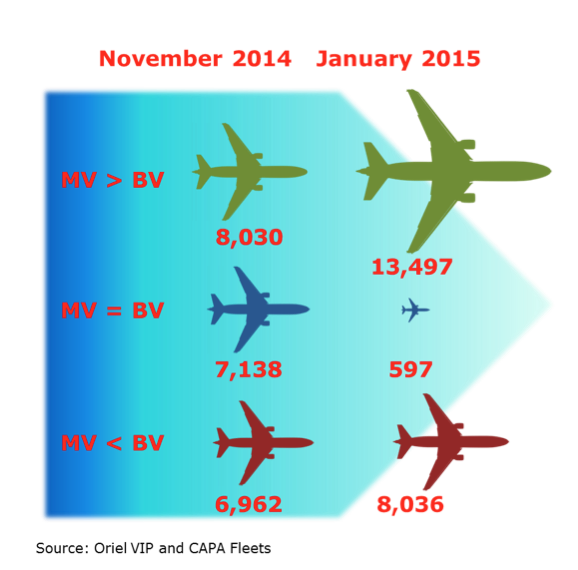
1. The in-production narrowbody sector; A320neo and CSeries arrive
2015 will welcome the first commercial flights for both the A320neo and CSeries. The former is predetermined to be a residual value success and the latter will hopefully be given an orderbook fillip which entry into service often provides.
When discussing market values and trends the context has to be relative to the underlying long-term base value. If market values decline less than the anticipated base value deterioration, this is a positive result.
The more important question is the value performance of the current A320 family. The last year has witnessed value and lease rate improvement for the A320 and A321 across all vintages. Perhaps this was not difficult after the last few years, but nevertheless welcome, especially for the aircraft labelled "middle aged" and which had borne the brunt of the value declines.
The A319 has recovered from the lows and the double over-wing exit aircraft fared best. Notwithstanding the recertification of the exit limit for the single exit aircraft has arguably put the former now at a disadvantage.
The A321-200 seems to be gaining a broader market acceptance during 2015; we would anticipate the aircraft and values building on this trend. The addition of the sharklet wingtip devices may enhance the value over and above the cost of the modification.
The A320-200 will again perform credibly, though the value improvement may not be as pronounced. Increasing the exit limit will also help and could narrow the gap with the 737-800, which seats an extra nine passengers.
The strong market may mitigate the depreciation of aircraft built at the tail end of production. The A319 may benefit from a tightening A320 market but the market value performance which matches base would in our view be a good outcome.
A320ceo and 737 NG orders by subtype (to year end 2014)

The Boeing 737-800 continues to be the leader of the pack with values across all vintages proving resilient. Even non-wingleted aircraft are easily placed. The market is always right, but to witness early vintage -800s priced at 50% more than similar vintage A320s could suggest that an -800 is heading for a fall. Yet we do not see that happening anytime soon.
The 737-900ER continues to underwhelm from a value perspective and in our opinion the market prices the aircraft lower than the A321-200. We would expect the general market optimism to support 900ER values in the coming year.
The 737-700 is suffering on a par with the A319, though its market is not hindered by engine choice, and value trends will mirror the Airbus competition. A number of aircraft continue to be parted out highlighting the weak demand as flyers and strong demand for used parts in the secondary market.
2. The out-of-production narrowbodies; perhaps below average value declines
The 737 classics and 757 are the mainstay of this grouping. Despite the fuel price movements which help the economics of these aircraft the best hope is for below average value declines.
For the 757, we expect to see more airlines to replace fleets. The write-down by Allegiant of their 757s tells the story for the type. The freight conversion programme will absorb some redundant aircraft. Our Base Values for these aircraft are conservative so moderate declines would see market values above base.
Boeing 757 in service fleet, average age
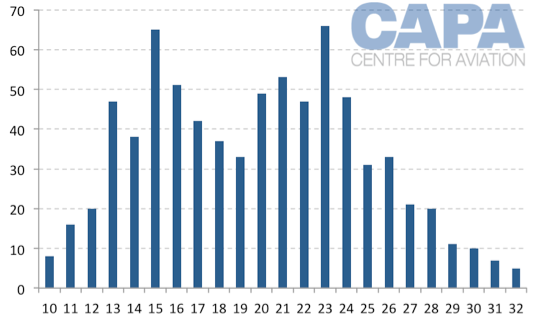
The values for the 737-400 have been helped by a perceived shortage of eligible feedstock for the freight conversion and the 300 market values have experienced reflected glory.
This is only likely to assist the values of later vintage aircraft, which are best suited to the conversion programme. We would expect the values of the freight versions to remain strong until the end of the decade, when maybe prices of 800s are at a level to support the modification.
3. The in-production widebodies
Since the financial crisis, two aircraft have been the star performers if measured by value retention, the A330-300 and the 777-300ER. Given both types have successors scheduled to enter service by the end of the decade how much longer will this above average value retention be maintained?
Airbus has acknowledged that production rates need to be reduced to better match demand, but as yet Boeing appears to be confident that it can sell the majority of empty slots. Whether it can maintain the historical monopoly pricing for the type is probably questionable.
A330 and 777 sales (excluding A330neo and 777X): 2009-2014
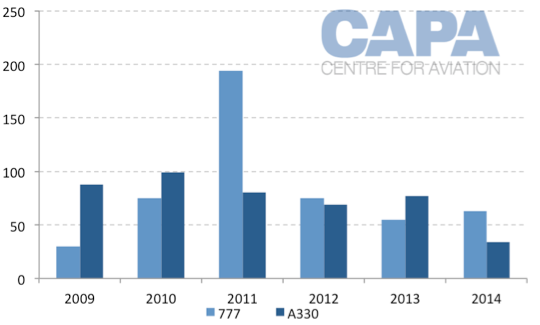
Indeed we believe there may be some relative weakness compared to the last few years for the 777-300ER. The A330-300 HGW, is a slightly older fleet and the ease and associated rates of placing aircraft at the end of initial leases will be informative. Historically the values and lease rates achieved have tended to be south of most appraisers' expectations.
The A330-200 value performance has, in our opinion, exhibited this unfortunate trend and the coming year will continue to see the Emirates fleet enter the secondary market and keep the aircraft competitive.
At Oriel we fully expect the 787 family and the A350 to take over the value retention mantle previously held by the 777-300ER and A330-300. The corollary is market values being above base for these types.
The A380 hit the headlines in late 2014 for the wrong reasons though we never believed the programme would be terminated. Indeed there may be more bad news this year for the type with the Transaero order looking vulnerable as a consequence of the crisis in Russia.
A number of early vintages are approaching the end of initial leases although we would not anticipate any change of operators. An outcome for these larger widebodies, which will suffer from liquidity issues and huge re-configuration costs, is that the vast majority remain with their initial operator for the duration. The asset exposure will be unpalatable for most third parties.
4. The out-of-production widebodies; despite lower fuel, probably little change
On paper, the likes of the 747-400, A340 family and 767-300ER should benefit from the lower oil price however we do not expect any significant reversal in their fortunes. Even more so than with the narrowbody category the other benefits make new technology more attractive in new long-range widebody aircraft irrespective of the oil price.
Our realistic expectations of base value retention suggest market values will be at par.
5. The widebody freighters; little prospect of recovery, with prices below base
The carnage in this sector has brought about a permanent diminution in values for a number of types that have been the backbone of the freighter fleet. Whilst we see little hope in recovery for the converted freighters, watch for more part-outs; the lower fuel price might enhance the prospect for the factory-built versions.
New build dedicated freighter orders by type: 2009 to 2014
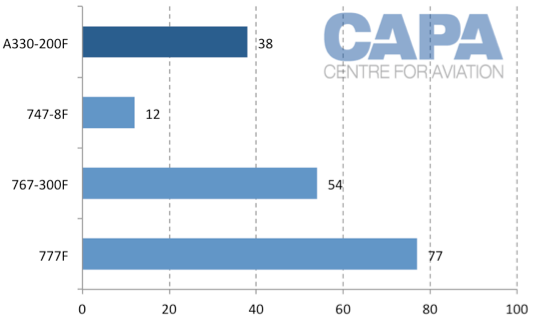
This is dependent on market demand recovering and 2014 looks to have been another year passing where it fell short of expectations. There is recognition that despite its shortcomings, belly freight is hurting the dedicated market and even science is bringing into question advantages of airfreight for 'fresh products'.
Apart from the in-production programmes, which have ridden out the storm with least value damage, the 767-300ER conversion and the now launched A330-200 conversion are in a segment where there is demand. Going forward we expect the market to become more realistic on the demand for converted widebody freighters. The days of expecting that redundant passenger widebody aircraft have secondary role as a freighter is history. It should be viewed as a bonus.
At Oriel we expect the freighters to be the laggards in the market with 2015 market values staying below base.
6. The regional jets; even fuel will not save the 50-seaters
The collapsing fuel price will not reverse the fortunes of the 50-seater jet market. The coming year will see more leaving US fleets as the market regroups around the larger aircraft and turboprops.
Embraer products are beginning to transition from original operators and in broad terms all variants have continued to fare well in keeping with market and lessor expectations. The two securitisations suggest investors are happy with the liquidity of the product when managed by sector specialists. Hence we expect to see the values too behave in keeping with the narrowbody in-production types.
Amongst the Bombardier products, the CRJ900 is clearly proving to be a good value performer. We anticipate some pressure on the CRJ700 market values: clearly in Europe it too is becoming too 'small' and the Lufthansa fleet heading to the part-out market suggest an element of weakness in demand. The Embraer E170 is also perhaps viewed negatively in Europe but customers are being found elsewhere for this variant.
7. The turboprops; still in rude health, but orderbooks raise questions
During the latter half of 2014 a little of the heat did leave the turboprop market, especially for the younger examples of out-of-production types. Nevertheless the market is still in rude health for the ATR and Bombardier products. Indeed the Dash 8-100 is gaining Twin Otter type value retention.
For the in-production variants, one may argue that the robust orderbook now contains far more orders from non-specialist lessors whose involvement might dilute the market. No sign of this happening so far although reduction in fuel prices might take economy focus away from turboprops and show off the market weaknesses.
In 2015 we at Oriel would expect the turboprop values on the "go steady" course without any dramatic movements in either direction.
Market values above, at and below base values by category
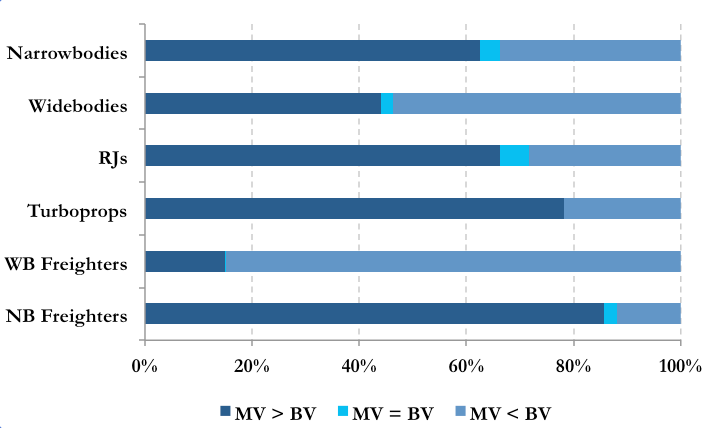
In summary, 2015 should be a good year for values, challenged by weakening demand
From a values perspective 2015 would appear to be a good year with the majority of types witnessing Market Values above Base. However the weakness in the underlying global economy could derail this trend, so one cannot be as optimistic for 2015 as we were at the same juncture in 2014. The crystal ball is definitely a little cloudier this year.
The low interest rate environment will probably continue well into 2015 and the small changes likely to be implemented should not undermine the market. Hopefully reaching the value peak will not be a prelude to a collapse and few years of positivity for values will follow.